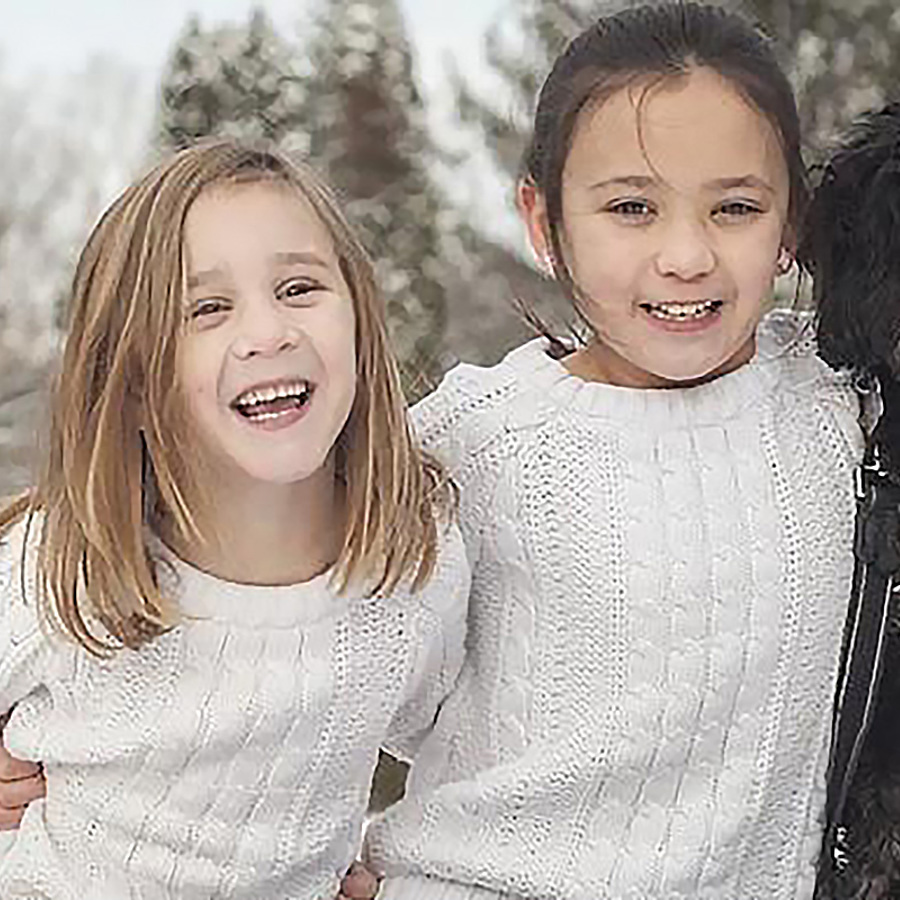
Can my sister and I have the same father even though our ancestry test results are different?
April 13, 2017

- Related Topics:
- Relatedness,
- Ancestry,
- Ancestry tests,
- Consumer genetic testing,
- Genetic genealogy
A curious adult from Texas asks:
“My sister and I had our DNA tested. We were raised with the same mother and same father - both are deceased. There has been talk in the family that we have different fathers.
Our ancestry test came back similar; however, we are not sure how much difference there should be in the percentages. For example: I am 50% Great Britain my sister is 39%, I am 10% Scandinavia my sister is 28% and other differences are 1 - 3%.”
From the ancestry data alone, you can’t tell if the two of you are half or full siblings. The differences in ancestry you have are pretty small; it’s normal for siblings to have different ancestry percentages.
As we talk about in a previous answer here, the two of you could even have much more different ancestries than this and still be full siblings! On the other hand, two totally unrelated people could have very similar ancestry percentages. Since ancestry percentages can vary so much, they’re not useful for determining if you’re related to someone.
Genetic data from an ancestry test can be used to determine if you are related
But you can use the genetic data collected in an ancestry test to figure out how you’re related to someone. There’s a lot to learn from your genetic data. Ancestry is just one thing we can learn from it. Whether two individuals are related is another thing -- but it just depends on how you or the company looks at the data. .
Some ancestry test companies also analyze your genetic data to figure out who you are related to in their database. For example, here’s what that looks like in 23andMe.
Assuming you both used the same ancestry testing company and both opt in to be discovered by relatives, you can use that company’s “close relatives” section to directly tell how the two of you are related.
How to use GEDmatch to figure out how you are related to someone
If the company you used doesn’t have a “find your relatives'' feature, your best bet may be to upload your genetic data to a website such as GEDmatch. For the rest of this article, I will walk through how to use that site to tell for sure if you’re full or half siblings.
GEDmatch is a free online service that lets you take your raw ancestry data and do lots of fun things with it. I’ll quickly go over one of their tools that will be able to tell you whether you are a half or full brother to your sister.
The first thing you need to do is to download your raw data from the company you used. I’ll show you how to do it with ancestry.com.
Sign in and click settings over in the top right hand corner. You’ll get to a page that has this in the right hand column:
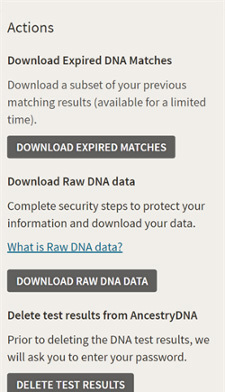
Click on the “DOWNLOAD RAW DNA DATA” and download the data to your computer. Do this for both you and your sister’s raw data.
Next sign in to GEDmatch where you will see this in the right hand column:
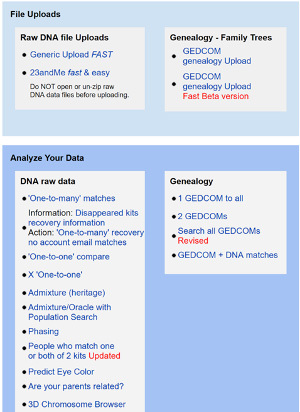
Upload both sets of raw data. Once you do that, click on the one to one compare (under analyze data).
This screen will come up:
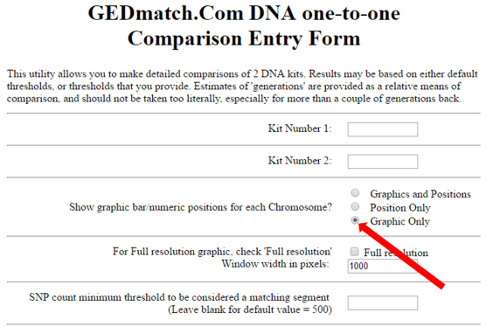
Paste in the two kit numbers (you will get those assigned to you when you upload your raw data).
Next click “Graphic Only” to get the easiest to understand set of results. (Well, these are the easiest for me.)
Click “Submit” and you’ll have your results. Now I’ll help you interpret what they mean.
Full vs. Half Siblings
Here is part of a typical result for full siblings (from Kitty Cooper’s blog):
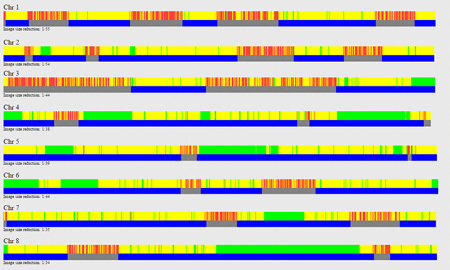
And here is part of a typical result from a half sibling (from the same blog):
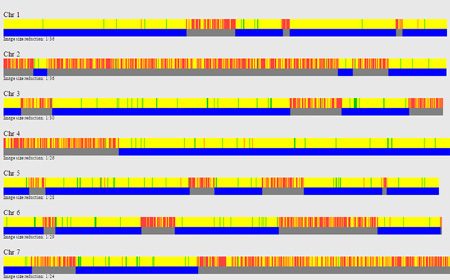
A close look shows a couple of key differences.
The most important difference is that the full siblings have blocks of green and the half siblings do not. Those blocks of green are not usually found in half siblings meaning that if you see lots of them, you are almost certainly full siblings.
The other big visual difference is that there is a lot more red in the half sibling compared to the full sibling. This is because full siblings share more DNA than half siblings and the red bits are sections where the two of you do not share any DNA.
As you can guess from that last section, you can also tell whether you are full or half siblings by the amount of DNA you share. Siblings share around 50% of their DNA while half siblings only share around 25%. The amount shared is usually expressed in something called centimorgans.
Full siblings tend to share around 3500 centimorgans while half siblings share closer to 1750. You can find those numbers at the bottom of the graphic image.
Yellow vs. green blocks
OK so the key difference here is green vs. yellow. If you have lots of big blocks of green you are almost certainly full siblings.
To get into what these different colors mean, we need to take a step back and talk a little bit about your DNA.
DNA is stored in long stretches called chromosomes. People typically have 23 pairs of chromosomes for a total of 46.
We get one chromosome in each pair from mom and one from dad. That is why we are half related to mom and half related to dad.
To get at yellow vs. green, let’s start by looking at one pair of chromosomes. Here is one pair of mom’s chromosomes:

I have made them blue so we will be able to better follow them and made one have a brick pattern for the same reason.
Now let’s add dad’s:
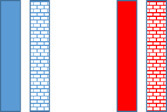
His are in red so we can, again, keep track of them.
Let’s have mom and dad have two kids who would be full siblings. Here is one way this might shake out:
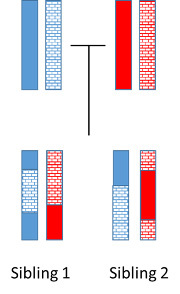
First off, notice that each child got half of his or her DNA from mom (blue chromosome) and half from dad (red chromosome). Note that they did not get the same DNA from mom and dad.
The other thing to note is that mom and dad did not pass down one chromosome or the other from the pair. Instead they each passed down a mix of their two chromosomes.
This DNA swapping, called recombination, happens whenever DNA gets put into the sperm or the egg. And the swapping can happen anywhere along the length of the chromosome meaning there are a huge number of different sets of chromosomes possible from the exact same parents.
OK, now we will compare the chromosomes from the siblings like this:
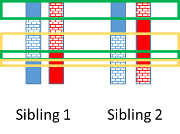
The green boxes, which correspond to the green parts in the GEDmatch image, are where the two siblings share DNA across all four chromosomes.
So in the top green box, both blue chromosomes have solid blue and both red ones have the brick pattern. All four chromosomes are the same at this position.
In the yellow boxes, DNA only matches on one set of the two chromosomes. For example, in the first yellow box, both blue chromosomes have the brick pattern but the first red one is brick while the second one is solid.
The unboxed regions are where the DNA is different on all four chromosomes. This would correspond to the red parts of the GEDmatch image.
So that is why full siblings have green, yellow, and red DNA. Let’s now do half siblings:
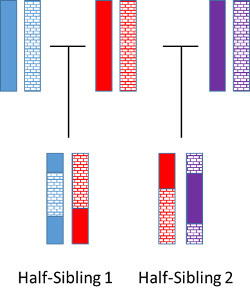
Here we have a common parent in red and different parents in either blue or purple.
Let’s compare our two half siblings the same way we did our full siblings:
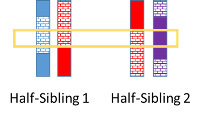
Because the purple and blue chromosomes don’t share any DNA, half siblings can never share across all four chromosomes. You can only get yellow and red but no green. There is no way to share DNA across all four chromosomes.
This is why the GEDmatch image is labeled like this:

A full match means it matches across all four and a half match just means it matches across two of the chromosomes.

Author: Dr. Barry Starr
Barry served as The Tech Geneticist from 2002-2018. He founded Ask-a-Geneticist, answered thousands of questions submitted by people from all around the world, and oversaw and edited all articles published during his tenure. AAG is part of the Stanford at The Tech program, which brings Stanford scientists to The Tech to answer questions for this site, as well as to run science activities with visitors at The Tech Interactive in downtown San Jose.
 Skip Navigation
Skip Navigation
